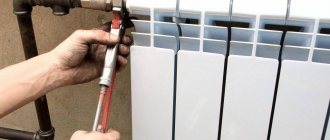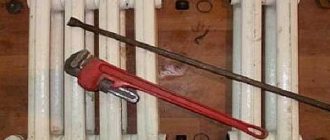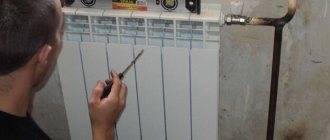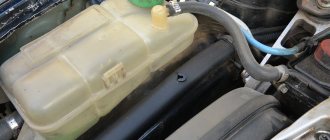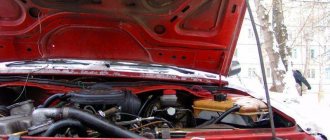The radiator is one of the main components in the car engine cooling system, which is installed in the front part of the body to intake cold air and cool the liquid circulating inside the pipelines. The system constantly operates under high mechanical and temperature loads, which leads to rapid wear and damage.
Very often, it is the cooling radiator that suffers first: small plastic and aluminum segments of the unit crack, through which coolant begins to leak. This is an unpleasant malfunction that is difficult to deal with on the road. However, the radiator needs urgent repairs!
Radiator related problems
The main problems with the radiator can be divided into two groups:
- Antifreeze leaks;
- The radiator becomes clogged with various debris and does not work one hundred percent.
It is quite simple to understand that there are problems with the cooling system; if the engine begins to overheat and the temperature begins to rise above 95 degrees, then the system cannot cope with the load. It is possible that the pipe has ruptured, or the radiator may have leaked. Often, an aluminum radiator is damaged as a result of accidents, stones, or careless repairs, because its honeycombs are quite soft, and plastic elements can crack upon impact. Any coolant (coolant) leak must be repaired if you want to avoid costly repairs to an overheated engine.
What affects the temperature of the engine?
The normal functioning of the motor largely depends on the degree of heating. Normal temperatures are maintained thanks to the cooling circuit. Correct operation of the engine is possible if the system is tight and in good working order. However, the circuit often leaks.
If damage appears at joints or on rubber parts, repair involves replacing them.
A leak in the cylinder head is considered more complex. In this case, the coolant level decreases and the engine begins to overheat.
What can happen if there is a lack of coolant?
If the radiator leaks or the pipe ruptures, the following may happen:
- The engine will overheat;
- The cylinder head gasket is deformed;
- When attempting to examine the problem, pressurized liquid may splash into the face, causing burns;
- The engine will seize.
All these troubles can lead to expensive repairs, and damage to health can be irreparable.
How to fix a radiator leak
One of the reasons that your car radiator is constantly leaking may be a broken radiator cap. Due to old age, the radiator cap may not hold pressure, as a result of which the antifreeze in the system will constantly evaporate. This problem is often invisible to the eye and although the entire system is in order, the antifreeze disappears somewhere. You should replace the cap with a new one and check the antifreeze level after some time. If the level is normal, then the problem is solved.
Radiator fluid often disappears due to wear and tear on the rubber hoses. This is easy to notice by the traces of smudges on the hoses. Such pipes are recommended for replacement, since their repair is not advisable.
The most problematic option is when there is a leak in the radiator itself. Often in such cases, repairs do not help. If there is a large crack in the radiator, it is immediately noticeable by steam and coolant splashes. A large hole can only be repaired in a garage or auto repair shop. Copper or brass can be soldered, aluminum can only be welded with argon. You should know that such repairs are unreliable and even a service station will not give you a guarantee for more than a month.
Finding a leak
The simplest and most effective way to detect a leak in a radiator is to dismantle and immerse the radiator with clogged pipes in a bath of water. Where there is a hole, water will flow in and air bubbles will begin to form.
If the leak is too small, it may not be detected naturally. Then you should connect a compressor or pump to one of the pipes to increase the internal air pressure in the radiator tubes.
A more reliable way to detect the smallest leaks is diagnostics using fluorescent components, which make it possible to detect even microscopic leaks in the seal of the radiator housing. But this is an expensive diagnostic that can only be carried out at a service station.
How to fix a car radiator leak using cold welding
Cold welding is often used to seal small cracks. It should be applied to a cleaned surface from which all contaminants must be removed. When the weld hardens, the crack will be sealed. Such repairs are not very reliable, since under the influence of high temperatures, cold welding loses its properties and becomes colored.
Some car owners, when their radiator is leaking, use “folk” methods to fix the problem. For example, they add dry mustard, which swells due to temperature and covers the cracks with its particles. Such repairs may result in large repair costs in the future. The channels, every thin tube, and even the coolant drain valve will become clogged. A faucet is essential when replacing a radiator, especially if you plan to do it yourself. A clogged tap will prevent you from draining the coolant and there will be problems with replacement. It’s better not to take risks and not use mustard, but to get to the repair site by constantly adding antifreeze.
The process of soldering aluminum products
Soldering an aluminum engine cooling radiator is an effective solution for eliminating various damages. But it is better not to carry out such repairs yourself. Soldering an engine cooling radiator is a rather complex and labor-intensive process. There are also many nuances to preparing flux. It is best to choose a powerful soldering iron - at least 50 W. It should be warmed up well before use.
If the radiator has thick walls, it is also advisable to warm them up. The solder must contain at least 50% tin. You can use POS-61. If there is less tin, then you should not expect high quality from soldering.
Flux is applied to the surface in a thick layer. Soldering is done in a circular motion, and the solder is literally rubbed into the damaged surface. This is a reliable way to repair cracks.
Copper radiators are repaired with more powerful devices with POS-60 and POS-40 solders. As for the technology, it is no different from the aluminum soldering process.
Repairing a cooling radiator using sealant
Leaking car cooling radiator - elimination
You can hear many stories about how car owners ruined their car engine due to the use of sealant. Often these stories are not fiction. So what should you do, use sealant or not? In fact, high-quality sealants cannot damage the engine; many people simply buy cheap analogues or fakes. It is also extremely important to choose the type of sealant that will help in your case. A properly selected composition will restore the tightness of the cooling system.
Types of sealants
There are three types of sealants:
- Powder;
- Liquid;
- Specialized.
Each of these types can cope with routine radiator repairs, but you need to choose them taking into account the size of the crack or hole.
Powder sealant is the cheapest. Often, instead of a specialized powder, car enthusiasts use mustard, which is not recommended. The powder is simply added to the antifreeze if your radiator is leaking. The main disadvantage of using powder is that it severely clogs the radiator channels and tubes.
Liquid sealant is made with the addition of polymers. These sealants can most often be purchased at car dealerships and gas stations. Metal particles are added to it. Liquid sealant clogs the cooling system much less, the main thing is to choose a quality product and not run into counterfeit products.
In addition to polymers, a specialized sealant also contains fibers, due to which it copes with larger damage. Of course, this is the best option among sealants, the only problem is its high price.
It is necessary to understand that the use of sealant is not a solution to the issue of radiator repair, but will only help to get to the place of global repair if the elements of the cooling system are leaking.
How to use sealant
Brief step-by-step instructions:
- Wait until the antifreeze cools down;
- Open the radiator cap;
- Pour sealant into antifreeze;
- Start the engine for a few minutes;
- Shut down and visually check the system for leaks.
If the damage was minor, the seal should be restored. When using low-quality sealants, you can clog the radiator with particles, damage the pump, disrupt the operation of the thermostat, and cause many more problems with the car. To avoid them, carefully study the information on the packages, look at the protection system and all kinds of holograms. When using, carefully follow the instructions included with the sealant. The main thing to remember is that the system with sealant must be restored in the near future.
To avoid major repairs, you should regularly check the cooling system for the slightest malfunctions and leaks, change hoses and pipes in a timely manner, and monitor the temperature of the antifreeze during operation. Also, do not forget to change the antifreeze, as over time it loses its properties, which can lead to problems with the entire system.
If you have any questions, leave them in the comments below the article. We or our visitors will be happy to answer them
Brief history of appearance
Radiators appeared much earlier than the first industrial sealants.
Therefore, even 20 years ago, drivers did not even think to be interested in which special sealant for the cooling system of a car engine is better, since there was no choice. Before the advent of these products, drivers had to look for other ways to urgently stop an antifreeze leak. If this is not done, the engine will suffer. Therefore, it was quite logical to sacrifice a less valuable element, that is, the radiator.
It’s difficult to find the original source, but one day a motorist came up with the idea of pouring mustard powder into the radiator. It is unknown what guided him in this, but his idea turned out to be effective. We managed to plug the holes for a while, add water and get to the garage for a full repair on our own.
It is reliably known that dry mustard was used by Soviet troops during the war in Afghanistan. After adding powder and adding water, military wheeled vehicles could cover another 300-500 kilometers of difficult travel under their own power. Of course, at the end point there was no talk of further movement. But changing a radiator is easier and cheaper than abandoning your equipment and ending up in enemy territory without transport. Plus, if the cooling system was empty, the engine would break down much earlier than 300-500 km.
Having such experience and knowledge, specialists in the field of auto chemicals began to develop special substances to combat leaks. They were called sealants. But even the manufacturers say that these are products for emergency situations and serve solely as a temporary measure. They give you the opportunity to get on your own to a place where a full-fledged repair will already be carried out.



